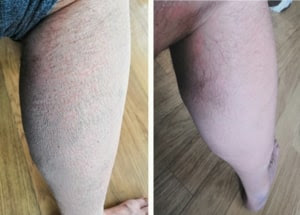Most Effective Ways to Manage Dry Skin
Millions of people worldwide suffer from dry skin, or xerosis, on an enduring basis. Occasionally just a temporary situation, dry skin can decline during winter when the humidity drops. For some individuals, however, dry skin doesn't fix quickly, leaving them to cope with the uncomfortable symptoms year-round.
Dry skin is typically seen on the arms, lower legs, and sides of the abdomen, but this can differ amongst individuals. In addition, the signs of dry skin will vary depending on a range of elements (including age), health status, outer environment, and the amount of time spent outdoors.
Dry skin may show the following symptoms:
- A sensation of skin tightness, especially after showering, bathing, or swimming
- Skin that seems shrunken or dehydrated
- Skin that feels and looks rough rather than soft
- Itching (pruritus) that sometimes may be quite painful. Individuals often scratch to reduce the itch.
- less to severe flaking, scaling or peeling
- Fine lines or cracks; even deep cracks, that may bleed
- Redness
The Causes of Dry Skin
To treat dry skin, it’s essential - To first comprehend what causes it. Although the skin is divided-up into different layers, it is the "epidermis" layer that is concerned in cases of dry skin. A thin layer, called the stratum corneum, covers the epidermis. There is space between the skin cells in the stratum corneum (the intercellular matrix) that is injured, leaving it unable to retain moisture and protect skin from the outer environment. This damage results in skin that is dry, rough, itchy, or even cracked.
Specific factors can lead to dry skin including:
- Dry air, over-heating, air movement
- Hot showers and baths
- Harsh soaps
- Alcohol-containing skin care products
- External conditions such as wind, cold air, sun
- Dehydration to some extent
Aging leads to a decrease in oil production and a less lipid barrier. Also, a decline in hormone production (estrogen in particular) in women leads to thinner skin and less fat deposits which can contribute to dry skin.
Your Sex. Men have more testosterone than women, and it is this hormone that can contribute to oil production. It can help prevent men's skin from becoming as dry as women's.
Medical disorders such as hypothyroidism
Drugs.Including retinoids, diuretics, antihistamines, and alcohol
Dehydration
Sun Direction. The sun can damage the intracellular matrix leaving dry skin behind.
Related Dry Skin Conditions
Several skin conditions may occur to be dry skin and while not technically dry skin, are related to it:
Keratosis Pilaris. Usually referred to as "chicken skin", keratosis pilaris tends to appear on the upper arms, legs, and even buttocks. Dry skin can contribute to keratosis pilaris
Ichthyosis Vulgaris. Sometimes as with fish scale disease "ichthyosis" occurs when skin cells fail to shed generally leaving small scales that can result in flaking on the scalp as well as; in the palms of the hand and soles of the feet.
Asteatotic Eczema (Eczema Craquelure).Asteatotic eczema results in dry, scaly, and very deeply fissured skin. Skin tends to be inflamed and itchy and constantly bleeds.
Psoriasis. Marked by reddened skin with dry, silvery scales, psoriasis sometimes reaches dandruff.
When to Pursue Medical Attention
Dry skin grows to be uncomfortable rather than dangerous, however, it may lead to more serious conditions when the skin's normal defensive mechanisms are severely compromised, as in the very young, the aged, or those who suffer from an infection. Here's when medical awareness may be required:
Eczema (Dermatitis)- If skin gives rise to redness, cracking, and inflammation, you may be wise to get medical aid.
Cellulitis - This potentially serious bacterial infection of the skin's underlying tissues may enter the lymphatic system and blood vessels. Antibiotics will most likely be necessary.
Basics of Treating Dry Skin
Dry skin is best-managed with a combination of practicing self-care and products that have ingredients to help remedy the condition. Prevent dry skin by remaining away from the triggers listed above and use moisturizers, topical exfoliants, gentle cleansers, and sunscreens liberally as needed.



Comments
Post a Comment